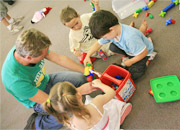Provide opportunities for practice
Did you know?
Children who are rushed can become frustrated, uncooperative and less able to function.
One of the best ways of nurturing good feelings and self-esteem is to encourage a child's already strong interest in doing things for themselves. An important component in the self-help environment is your attitude. Even if it is inconvenient or seems time consuming, the time is well spent allowing children the opportunity to practice developing skills.
Think about how you learn - is it different to the way your friend learns? Do you pick things up quickly or do you like to practice a few times before you feel confident? Children are just the same - each one will have its own preferred way of learning.
Planned and spontaneous experiences
The experiences you design for the children in your care will be based on aims and objectives depending on the needs of the children. Below is an example:
Aim: To encourage self help skills.
Objective: Emily (2 years) will pack away after using an experience or toy.
With this aim and objective in mind, staff can allow the child opportunities to practice the skill in two ways:
Planned experiences

If a child is learning a particular skill or task, you can plan an experience that involves the skill or task.
For example, you might design an experience that uses 'pack away' music or a song to make packing away toys and equipment a fun activity and encourage the children to join in.
Spontaneous experiences
You will also come across opportunities during day-to-day routines in which the child can practice the skills or task. Spontaneous opportunities should be used together with planned experiences to facilitate a child's learning.
For example, you might find Emily sitting back on the cushions watching others play. You could go and sit next to her for a chat and while doing so, find that the children Emily was watching are now packing up the equipment they were using before they move on. This provides you with the opportunity to discuss how the others packed away – “Look how neatly the toys are on the shelf.” or “Now when someone else wants to play with those toys they will have no trouble finding them.”
Everyday opportunities to build self-help skills
Below are some examples of how you can help children build self-help skills during everyday activities such as mealtimes, nappy changing, toileting, dressing, sleep time and cleaning.
All of the resources below on Building self-help skills are contained in the Resources section, under Caring for children.
Building self-help skills: mealtimes
Building self-help skills: toileting
Building self-help skills: dressing/undressing
Building self-help skills: sleep/rest time
Building self-help skills: packing away/caring for the environment
Choose one of the Building self-help skills resources you just read. Write a summary of it in your notebook.




